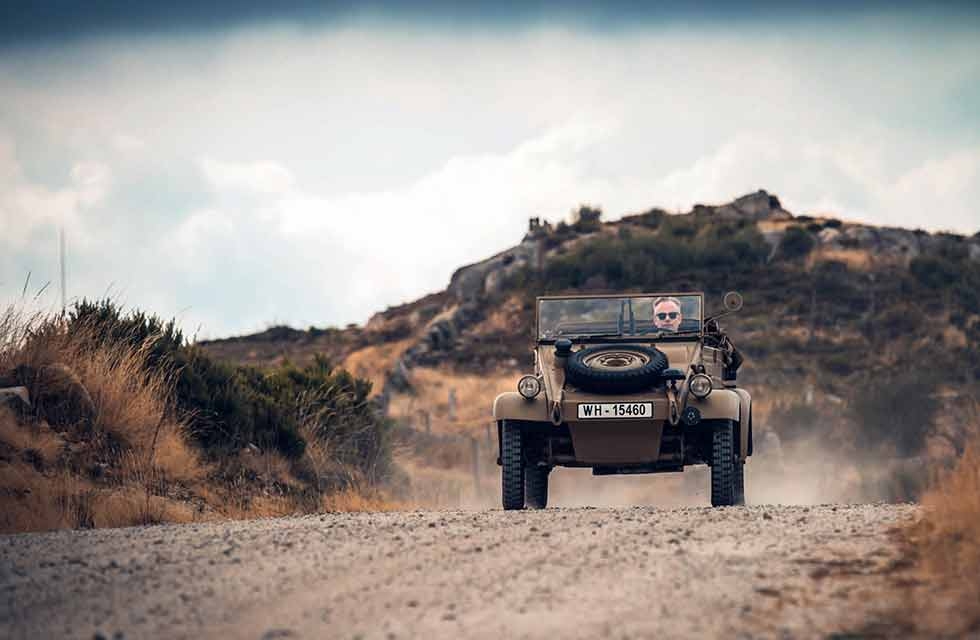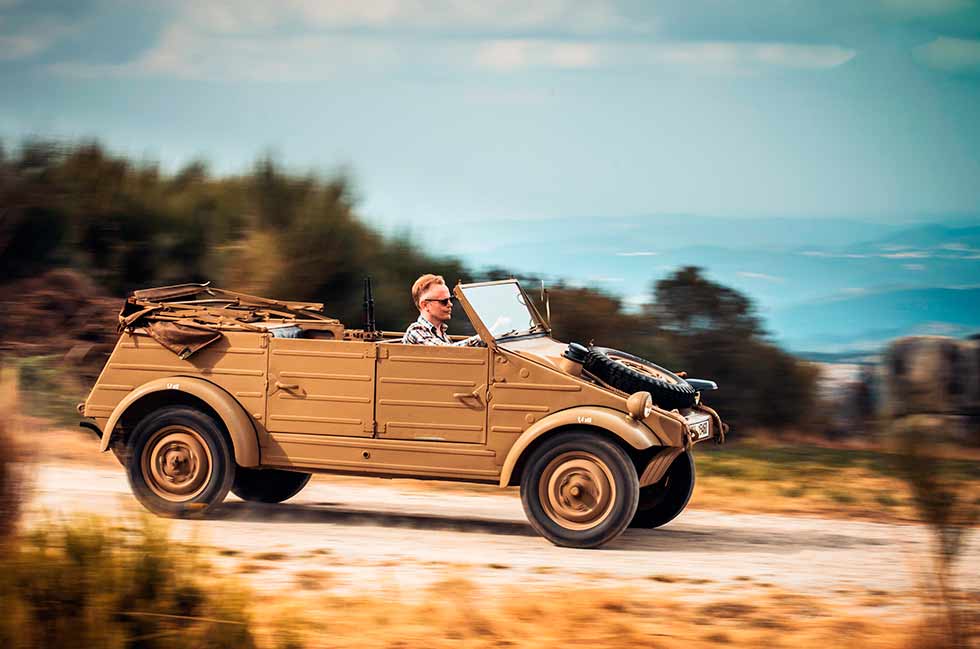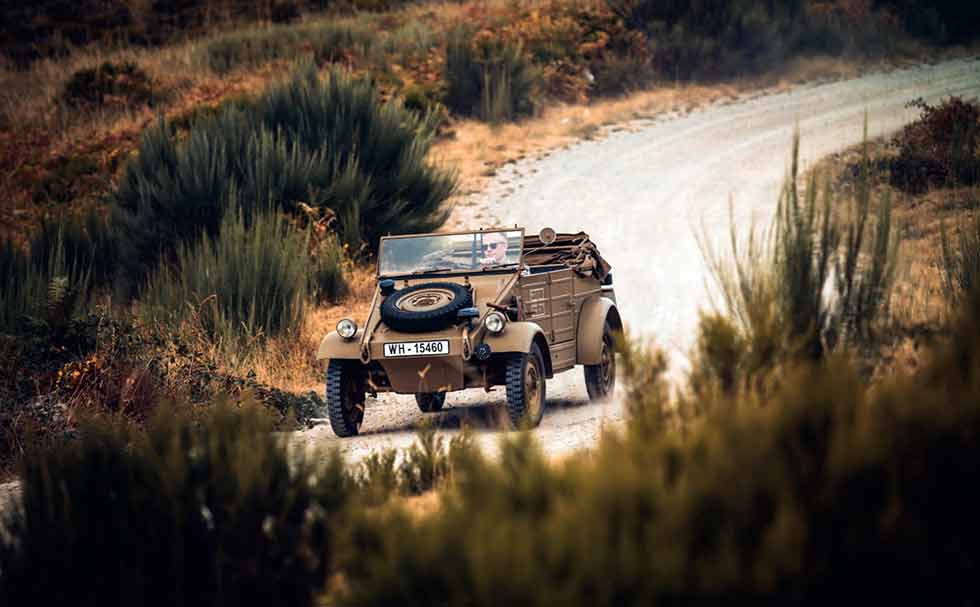
Its origins lie in the darkest of times, but the clever and capable Volkswagen Kübelwagen deserves its classic status. Words Richard Heseltine. Photography Manuel Portugal.
CHARM OFFENSIVE THE BEETLE GOES TO WAR
Richard Heseltine is bowled over by the Kübelwagen, Germany’s Jeep alternative

We appear to be heading down an ex-road. The air is thin up here, that’s for sure. This always happens when a photographer is on point: you never know where you’re going to end up. The sound of stones clattering the undercarriage leaves you with an accordion-scrunched face; you cannot help but wince. The camera car bounces off into the distance, a cloud of dust obscuring much of the trail ahead, not least where the deeper gullies are located. But then the sun’s rays blast erumpent through the sandy haze. Suddenly, the khaki-coloured landscape makes way for panoramic views as far as the eye can strain.

The scenic vistas of Portugal’s Serra do Caramulo region are of the heavenly variety, but somehow you expect this Volkswagen Type 82 – or Kübelwagen – to be that bit more… purgatorial. It isn’t. The first revelation strikes you barely a hundred metres after heading off-piste: it’s brilliant over rough terrain. Sure, your buttocks don’t stay connected to what pass for seats for more than a picosecond over the larger bumps, yet it seems to negotiate craggy surfaces like a tossed pebble skims water. It feels as though you’re airborne much of the time, but your spine doesn’t act as a shock absorber on landings. Secondly, it’s eager. Its 1131cc air-cooled four-banger produces whole tens of horsepower, but then it weighs only 1100lb (499kg), or thereabouts. As such, it buzzes along on the loose stuff with zeal. It’s fun to drive. So much so, you feel conflicted admitting as much.

You see, ‘fun’ isn’t a word often coupled to anything associated with the Wehrmacht. But the Kübelwagen’s legacy has in many ways outrun the 1000-year Reich that led to its creation. Strictly speaking, though, there was more than one kind of Kübelwagen. It was a nickname, after all, and certainly wasn’t a compliment. It became a term of endearment only in retrospect. The story began in Berlin’s Kaiserhof Hotel in May 1933, when Adolf Hitler expounded his idea for a ‘People’s Car’ to Dr Ferdinand Porsche.
This brave new world should use no more than seven litres of fuel per 100km (which equates to about 40mpg), he insisted. It also needed to have four seats and be capable of maintaining 100kph on the new autobahns, which were then in the throes of creation. At the following year’s Berlin motor show, Hitler announced that: ‘Due to the superb designer Porsche and his staff, we have succeeded in completing preliminary designs for a German People’s Car.’
“The rear lights work as a code, so the car following in a convoy knows how far apart you are, whether in the sand, dark or fog”
Road tests began in October 1936, and in May 1937 the lyrically named Gesellschaft zur Vorbereitung des Deutschen Volkswagens mbH (Company for the Preparation of the German Volkswagen Ltd) was established to produce 1,500,000 cars. Hitler had long been impressed by Henry Ford and his mass-production techniques (plus some of his more unsavoury world views), and insisted that within 10 years no working person in Germany would be without a ‘KdF-Wagen’. Not only that, but a stamp-saving scheme was also inaugurated on 1 August 1938, where, for five Reichsmarks a week, such volk could order one for delivery soon after the car entered production. Remarkably, 336,668 punters took the plunge.
Three months earlier, amid the Czechoslovakia Crisis, Hitler laid the cornerstone of a new – and vast – factory in Wolfsburg. Progress was hampered, however, by a lack of local labour.
Benito Mussolini attempted to alleviate the problem by sending unemployed Italian workers over. Nevertheless, no cars were manufactured in series prior to the start of WW2. Tragically, the construction staff would over time be augmented by captured Poles, followed by natives of France, Belgium, The Netherlands, Denmark and Russia. The few Volkswagens that had been made thus far were either destroyed or presented to officials of the Nazi Party. A portion of the factory, some of which still lacked a roof, was given over to the German Ministry of Armaments. The plant was then used for the manufacture of everything from heating stoves to hand grenades and, towards the end of the war, the assembly of V-1 flying bombs.
‘You expect it to be that bit more… purgatorial. It isn’t. It’s brilliant over rough terrain, buzzing along on the loose stuff with zeal’
Plus, of course, the Kübelwagen and its amphibious ‘Schwimmwagen’ sibling. Scroll back to the mid-1930s and a priority for the Wehrmacht’s all-important blitzkrieg was motorisation. The need for a small and agile vehicle for carrying troops in the field was obvious, and several manufacturers, Opel and Mercedes-Benz among them, had previously created their own take on the Kübelsitzwagen – or ‘bucket-seat car’ – theme that originated in the early 1920s. The moniker, which was subsequently shortened to Kübelwagen, referred to the seats employed to prevent occupants from spilling out due to their open-sided flanks. In January 1938, Hitler’s chauffeur/bodyguard turned SS commander Sepp Dietrich gave Porsche the nod to develop a military version of the Volkswagen. The brief specified that the vehicle should weigh no more than 2090lb (950kg) with four fully kitted-out soldiers onboard, and a maximum of 1210lb (550kg) unladen. The doctor turned to Karosseriefabrik Nikolaus Trutz, a firm well versed in military vehicles, for help with the body design, with prototypes undergoing testing from November 1938. Despite lacking Hitler’s preferred four-wheel- drive set-up, this newest Volkswagen variant – dubbed Type 62 – proved adept off-road thanks in part to its lack of heft and its ZF-made self-locking differential. Pre-production editions were then tested in the field during the invasion of Poland.
Further developments, which stretched to larger 16in wheels to improve ground clearance and new axles with gear-reduction hubs, were subsequently employed on the production Type 82 Kübelwagen that entered volume manufacture in February 1940. The bodywork, including doors and mudguards, was fashioned from steel by Ambi-Budd Pressewerke. All told, 50,435 were made until 1945. It isn’t as though the VW wasn’t improved along the way, however, with later versions being identifiable by their longer rear mudguards and folding front tow hooks. There were also significant tweaks for use in some of the sandier theatres of war, with special split-rim wheels and balloon tyres being developed by Continental for use in North Africa.
There were also umpteen spin-offs and prototypes, ranging from pick-ups and radio cars via a bizarre stab at a half-track.
Intriguingly, a Kübelwagen captured by the US War Department was evaluated at Camp Holabird, Maryland, in November 1943, the same venue where the original Jeep prototypes were appraised. Predictably, the published findings made for unflattering reading. The report stated: ‘The Volkswagen, the German equivalent of the American Jeep, is inferior in every way, except in the comfort of its seating accommodations.’
Nevertheless, the US Army was sufficiently astute to realise that its soldiers would likely secure and use Kübelwagens so prepared a comprehensively detailed operator’s manual. It describes it as being: ‘A four-wheeled, rubber-tyred, rear-axle-drive personnel carrier and reconnaissance car, comparable in purpose and size to the American ¼-ton truck.’
Humber, meanwhile, wrote a lengthy report that same year on a ‘German Light Aid Detachment Vehicle’ seized in the Middle East.
It concluded: ‘A study of the engine indicated that the unit was, in certain details, most inefficient… It is very doubtful whether it was even capable of giving reliable service had it produced performance commensurate with its size.’
It went on to add: ‘Looking at the general picture, we do not consider the design represents any special brilliance, apart from certain detail points, and it is not to be regarded as an example of first-class design to be copied by the British industry.’ The Light Car took great delight in running these quotes and others like them in its report on the VW in 1943, each damning verdict building to a final rousing put-down: ‘As tobacco is scarce in Germany, Dr Porsche, the designer, can put that in his pipe and smoke it.’
The Kübelwagen is nowadays much in demand, its rarity ensuring that asking prices tend to be around the £45,000 mark. That’s roughly twice the value of a comparable Willys, according to the owner of this particular example, Salvador Patrício Gouveia. “I bought it back in 2005 from a Canadian museum that was selling its collection,” he says. “It was my childhood dream car, so I jumped though lots of hoops to secure it. I stretched everything to the limit because I had only just started employment back then. It’s a 1944 model that served in Germany. People commonly think that its tan colour signifies that it saw service in North Africa with the Afrika Korps, but the truth is that the Wehrmacht decided in 1943 that all vehicles should be painted this colour, independent of which front they were deployed on.”
He is also loath to agree with Humber’s wartime assessment: “I love the simplicity and its clever functionality. Nothing is locked, everything opening with a simple movement. It was made to be as practical as possible. The side doors, for example, open through 180º, while the windows can be installed and removed in seconds with just two little bars that stick in the door holes. Also, the cargo section opens in several different ways for ease of access, while the rear lights work as a code so the car following in a convoy knows how far apart you are, whether in the dark, sand or fog [via a series of flaps and coloured lenses]. Then there’s its simple engine, which doesn’t require water to cool it down. That was an important feature when fighting in Russia where other vehicles’ liquids froze. Not only that, but soldiers could also easily get to the shovel, the battery, the weapons – it’s a work of genius, no doubt about it.”
Intriguingly, an unnamed British officer in the REME described his experiences of driving a Kübelwagen in The Motor in June 1944. He wrote: ‘Shortly after capturing the VW, I made a trip down to Syracuse in Sicily. The only disturbing thing about the car was the speedometer, which, of course, read in kilometres. It was amusing to see my batman’s face when, on a good straight stretch, I pointed to the speedometer, which was indicating a shade over 100. The VW can take corners a great deal faster than most staff cars, without the swinging tendency of the Jeep.’ The officer survived a ‘moment’ on entering Carlini, during which the Kübelwagen slithered off the road before connecting with some rocks. He added: ‘It had both front shock absorbers and one front spring smashed. It has been the only occasion on which the Volkswagen let me down in some 5000 kilometres on the island and in Italy. Long may it continue to serve the Allied cause so faithfully.’ None of which would have been music to the ears of the Wehrmacht, which was rather the point.
Viewed dispassionately, or better still in a vacuum, it’s hard not to fall for the Kübelwagen. Sure, it has trouble getting out of its own way on paved roads, and it has a tendency to wander, but it’s just so much… Fun. Is it a better vehicle than a Willys Jeep? No, just different. Both endear themselves on so many levels, and both have their flaws. The difference is that the Jeep became redolent of the Allies’ victory and entered into legend. It also became a big hit in peacetime. The Kübelwagen, in contrast, did not, for obvious reasons.
Nevertheless, VW revived the basic template in 1969 with the Type 181, created for the Bundeswehr, the German Federal Armed Forces. It also found some degree of success in the civilian market. And, of course, innumerable beach buggies have proved the off-road Volkswagen concept beyond all shadow of a doubt.
The covers might have changed, but the book was very much the same.
Thanks to Adelino Dinis, Salvador Patrício Gouveia and Tiago Patrício Gouveia (www.museu-caramulo.net)
Clockwise from main: it’s capable – and surprisingly comfortable – on rough terrain; ZF self-locking diff helps progress off-road; easy-access shovel; pram-style folding roof; 1131cc ’four’; 50,435 were built and this now-rare VW is unexpectedly endearing.
Clockwise from main: contrary to popular belief, the tan colour doesn’t denote desert use; basic cabin; rear lights send coded messages; 16in wheels; accommodation for four; steel body, including mudguards, but it weighs only around 1100lb.






